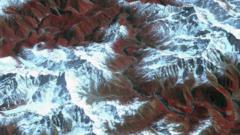China has officially commenced the construction of what is projected to be the world's largest hydropower dam, located in Tibetan territory along the Yarlung Tsangpo river. The project, marked by a ceremony overseen by Chinese Premier Li Qiang, is expected to have far-reaching ecological and geopolitical implications, notably raising alarms in India and Bangladesh, whose populations rely on the river’s resources.
Estimated to cost 1.2 trillion yuan ($167 billion), the Motuo Hydropower Station, once completed, will surpass the Three Gorges Dam in energy production, potentially generating threefold the energy output. While Chinese authorities claim the project will prioritize ecological balance and stimulate local economies, experts warn that its construction could harm millions living downstream.
The river's trajectory is crucial, as it passes through Arunachal Pradesh and Assam in India before flowing into Bangladesh, feeding into key rivers such as the Brahmaputra and Jamuna. Leaders in Indian states have expressed deep concerns, fearing that the dam could diminish water flow significantly, posing an existential threat to local tribes and their livelihoods. Pema Khandu, Arunachal Pradesh's chief minister, emphasized the anxiety over potential sudden water releases from the dam, which could devastate local ecosystems and communities.
India’s Ministry of External Affairs has previously communicated concerns to Beijing regarding the impact of such mega-projects, urging China to consider the interests of affected downstream states while ensuring transparency throughout the process. In response to these apprehensions, India plans its own hydropower project on the Siang river to counteract potential flooding risks stemming from Chinese developments.
Additionally, Bangladesh has also sought clarification from China regarding this ambitious dam construction, highlighting shared concerns about water management and its implications on their water supplies.
Situated in the Yarlung Tsangpo canyon, noted as the longest and deepest canyon globally, the dam reflects China's strategic efforts to harness the hydropower potential of its western regions while addressing energy demands in eastern metropolises. Monitored by a policy dubbed "sending western electricity eastwards," this initiative seeks to unfold in tandem with Beijing's broader goals of reducing pollution and fostering economic growth.
However, local advocates are raising alarms, pointing out that such developments often lead to exploitation of Tibetan lands and communities. Past protests against similar projects were met with violent crackdowns, creating an atmosphere of fear and suppression among those opposing the state's actions.
Environmentalist warnings are also mounting regarding the risks of constructing large dams in seismically active regions like Tibet, alongside concerns about biodiversity loss in valleys set to be submerged.
As the world witnesses this new phase in China's hydropower ambitions, the immediate future remains uncertain for the millions who depend on the downstream waters. The question lingers: will this colossal endeavor serve as a pathway to a sustainable future, or will it ignite long-standing regional tensions and ecological dilemmas?
Estimated to cost 1.2 trillion yuan ($167 billion), the Motuo Hydropower Station, once completed, will surpass the Three Gorges Dam in energy production, potentially generating threefold the energy output. While Chinese authorities claim the project will prioritize ecological balance and stimulate local economies, experts warn that its construction could harm millions living downstream.
The river's trajectory is crucial, as it passes through Arunachal Pradesh and Assam in India before flowing into Bangladesh, feeding into key rivers such as the Brahmaputra and Jamuna. Leaders in Indian states have expressed deep concerns, fearing that the dam could diminish water flow significantly, posing an existential threat to local tribes and their livelihoods. Pema Khandu, Arunachal Pradesh's chief minister, emphasized the anxiety over potential sudden water releases from the dam, which could devastate local ecosystems and communities.
India’s Ministry of External Affairs has previously communicated concerns to Beijing regarding the impact of such mega-projects, urging China to consider the interests of affected downstream states while ensuring transparency throughout the process. In response to these apprehensions, India plans its own hydropower project on the Siang river to counteract potential flooding risks stemming from Chinese developments.
Additionally, Bangladesh has also sought clarification from China regarding this ambitious dam construction, highlighting shared concerns about water management and its implications on their water supplies.
Situated in the Yarlung Tsangpo canyon, noted as the longest and deepest canyon globally, the dam reflects China's strategic efforts to harness the hydropower potential of its western regions while addressing energy demands in eastern metropolises. Monitored by a policy dubbed "sending western electricity eastwards," this initiative seeks to unfold in tandem with Beijing's broader goals of reducing pollution and fostering economic growth.
However, local advocates are raising alarms, pointing out that such developments often lead to exploitation of Tibetan lands and communities. Past protests against similar projects were met with violent crackdowns, creating an atmosphere of fear and suppression among those opposing the state's actions.
Environmentalist warnings are also mounting regarding the risks of constructing large dams in seismically active regions like Tibet, alongside concerns about biodiversity loss in valleys set to be submerged.
As the world witnesses this new phase in China's hydropower ambitions, the immediate future remains uncertain for the millions who depend on the downstream waters. The question lingers: will this colossal endeavor serve as a pathway to a sustainable future, or will it ignite long-standing regional tensions and ecological dilemmas?




















